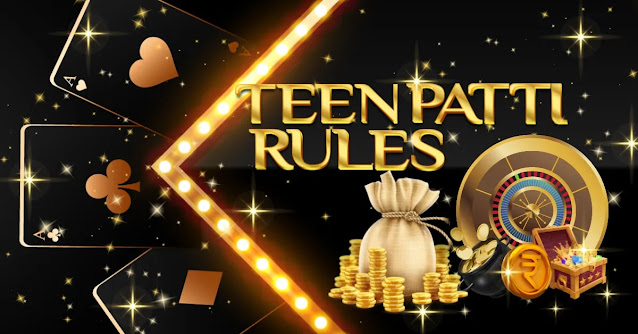Boost Your 3 PATTI RULES With These Tips | Beginner's Guide!
Do you wish to play Teen Patti, a famous Desi card game in India, but don't know how?
Don't be concerned. This page offers a comprehensive collection of 3 Patti Rules.
Teen Patti, a popular Desi card game in India, is one of the country's most popular gaming card games. Continue to try to figure out how to play Teen Patti India and what concepts you should be aware of.
It is a card game that originated in India and is now popular throughout South Asia. The game is a rearranged version of three-card poker known as 'flash' or 'flush.'
Learn How to Play Teen Patti Game and the Rules
Teen Patti, a popular Desi card game in India, is a card game for 3 to 6 players that employs a 52-card deck with no jokers. Teen Patti India, like other Poker and rummy games, begins with the placement of a token. Before the cards are dealt with, a specified amount of tokens must be placed by participants.
After each player has placed their token and the total sum has been tallied, each player is dealt three cards face down. The boot sum is the number of tokens maintained in the pot as a starting point. The pot is on the table.
After the player and sellers have been dealt three cards, the next step is to call or raise. If you've ever played Poker, a popular Desi card game in India, you should be familiar with these two phrases. Making a call implies that the player will remain in the game but will not increase his token; on the other hand, making a raise means that the player will add tokens to the pot, so play to win or lose more than the initial gaming token.
In any case, it's crucial to remember that playing Teen Patti, a popular Desi card game in India, isn't the same as playing Poker. All tokens in the Teen Patti app must be in equal amounts, which means that if a player places two coins and another player places four coins, the preceding player must add four coins to the earlier two.
The prize pool grows as the game progresses, and the person who stays in the game until the end of the hand with the best or most elevated hand wins. It is decided by arranging the cards from most important to least significant.
Hand Ranks: 3 Patti Rules, A Popular Desi Card Game India
To win at Teen Patti, a popular Desi card game in India, you must have a better hand than the other players. The ranking of hands in the 3 Patti game, often known as sequences, is as follows, from high to low:
Trail Rr Set (three of the same rank)
In Teen Patti, a trail, set, or trio is formed by three cards of the same kind, regardless of color or suit. Three Aces, for example, constitute the highest trail in this hand, with one of each of the clubs, diamonds, and hearts.
Three Aces of clubs, diamonds, and hearts (A-A-A) on their own also belong to the same hand rank. Queens, Jacks, 10s, and the rest come in second and third place, respectively. The lowest ranking is 2-2-2.
Pure Sequence Or The Straight Flush
This three Patti sequence or hand configuration in Teen Patti Game is called the pakki round by Indian players. It is made up of three consecutive cards of the same suit. The highest-graded hand in a pure sequence in the traditional game is an A-2-3 of hearts, diamonds, spades, or clubs.
In some circumstances, though, the highest rank is given to A-K-Q. At the end of the series, 4-3-2 obtains the lowest rank. Please keep in mind that neither 2-A-K nor K-A-2 are viable pure sequences.
Sequence (straight or run)
In the Teen Patti game, a run or straight sequence replicates a pure sequence. The hand consists of three consecutive cards of different suits. In the classic game, the highest-ranking hand is also A-2-3.
The variant, on the other hand, makes it A-K-Q. The lowest-ranking hand in the series is 4-3-2. 2-A-K and K-A-2 are plainly not viable straight sequences.
Color
A color or flush in Teen Patti is a hand of three cards from the same suit that are not in order. In this sequence, the highest-ranking hand is A-K-J of spades, clubs, diamonds, or hearts, followed by A-K-10, A-K-9, and so on. 5-3-2 is the lowest-ranking color or flush sequence.
Pair (two cards of the same rank) (two cards of the same rank)
In the Teen Patti game, a pair or double is formed by two cards of the same rank, regardless of color or suit. Teen Patti's highest-ranking pair is two Aces of any color or suit. When two players are dealt an identical pair of cards, the value of the odd card determines who has the better hand.
The highest-ranking sequence is A-A-K, whereas the lowest-ranking sequence is 2-2-3.
High Card
Teen Patti's high card resembles a flush in appearance. The hand is made up of three cards from diverse suits that are not in any specific order. The best hand is A-K-J, while the worst is 5-3-2. If two players share a common high card, the higher-ranking hand is determined by the next high card.
The Show
When all but two players have folded, one of them may request a showdown. If this is the case, both players must expose their cards. The following are the show's rules:
if they have a chance to do so. if they have a chance to do so. if they have a chance.
If there are only two players left, any of them can request a show. Both must place 1x the current amount.
No player (including the players themselves) is allowed to look at their cards before paying for the show.
If there are only two players left, any of them can request a show. They will each pay twice as much as the current token.
A blind player can request a show from another player.
The blind token must be 1x the value of the current token. The blind players must bet twice as much as the players.
When one of the participants is blind, they cannot request a show. The player's only options are to play or to withdraw.
Both players' cards are revealed during the show. The person with the best hand wins the pot.
If both players have an equal hand, the player who paid for the show loses.
The winner becomes the dealer in the following game.
Compromise
If you're playing Chaal, you can also request a compromise, often known as a sideshow. The following are the guidelines for reaching an agreement:
All gamers must initially deposit a minimum amount (Ante).
When it's your turn to place your next token, you can negotiate with the player who placed before you (the person on your left side). However, you can only do so if the player in front of you is playing Chaal.
It would be great if you used the previous player's current amount.
The other player can accept or reject the compromise.
If the other player accepts the compromise, you must compare your cards. The player with the lowest-ranking hand is compelled to fold. If the cards are deadlocked, the person who suggested a compromise must fold.
If the opposing player rejects the compromise, the following player takes the turn.
Different Rules Apply to Teen Patti Variations.
The restrictions described in this article relate to Teen Patti, a popular Desi card game in India on the internet. The 3 Patti game, on the other hand, exists in a multitude of variations.
The rules for the many game types vary somewhat. Our Teen Patti version, a popular Desi card game in India, has particular criteria for all sorts of modifications.
Are you ready to play Teen Patti Game in India? Download the 3 Patti Game App right now!
Check out our website Hobigames if you want to learn and discover more things about this.



Mga Komento
Mag-post ng isang Komento